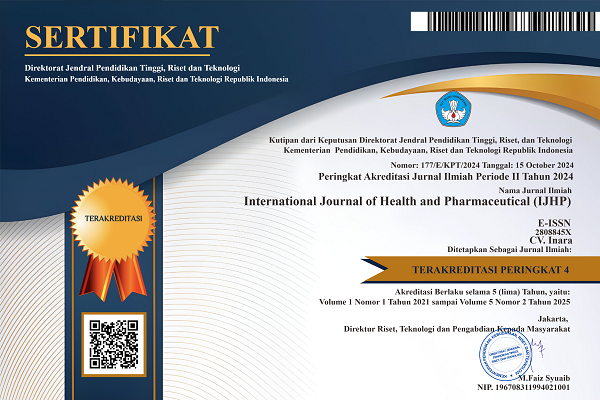Evaluating Chromosomal Microdeletions And Duplications: Ethical Considerations In Life Expectancy For Pediatric Bilateral Cryptorchidism – A Local Community Perspective
DOI:
https://doi.org/10.51601/ijhp.v5i2.414Abstract
Introduction & Objectives: Cryptorchidism is one of the most frequent congenital birth defects in male children and is present in 2–4% of full-term male births. The study aims to validate the associated genomic information to pick up and catalog life expectations with our community's associated syndromes and pathologies. Materials & Methods: The study was carried out between the 1st of June 2014 and the end of December 2018. G-banding of metaphase chromosomes and high-resolution karyotype analysis was performed in all patients using 5 DNA probes, ordered in the deletion intervals, and correlated with the cytogenetic map of the chromosome and sequence tagged size (STS) in the molecular study of microdeletion and microduplication using fluorescence in situ hybridization (FISH). The data were translated to the Statistical Package for Social Science (SPSS) version 22, Excel 2016 . Results: Out of 124 managed and operated on patients, genitourinary anomalies were the most common associated pathologies in 44% of cases, and hypospadias was the most common in 21.77%. Developmental delay and intellectual disabilities with speech disorders are considered the second one 24.19%. Y chromosome microdeletions were observed in 75% of all, the most considered one Y q1.2 D in 45.16%, p-value < 0.05. X p11.2 micro duplications were observed in 8.78% of the cases. Higher ascent of the testis presented with more microdeletion (intra-abdominal 35.48% of the patients) p-value < 0.05. With the STS, sY84 & sy86, and the loci, DYS 273 & 148 the azoospermia factor A region (AZFa) was estimated in 39.51% of the patients. Conclusions: Genomic information and screening are recommended for bilateral cryptorchidism as the chromosomal microdeletions and microduplications have been associated with a spectrum of pathologies, considering this with a catalog of the multidisciplinary team and complete disease network to follow up the clinical pictures after surgery.
Downloads
References
Virtanen He, toppari J. Epidemiology and pathogenesis of cryptorchidism. Hum Reprod Update 2008; 14:49–58.
Iafrate AJ, Feuk L, Rivera MN, Listewnik ML, Donahoe PK, et al. 2004. Detection of large-scale variation in the human genome. Nat. Genet. 36:949–51
Itsara A, Cooper GM, Baker C, Girirajan S, Li J, et al. 2009. Population analysis of large copy number variants and hotspots of human genetic disease. Am. J. Hum. Genet. 84:148–61
DP, Sharp AJ, McCarroll SA, McGrath SD, Newman TL, et al. 2006. Linkage disequilibrium heritability of copy-number polymorphisms within duplicated regions of the human genome. Am. Genet. 79:275–90
Foresta C, Moro E, Garolla A, Onisto M, Ferlin A. Y Chromosome Microdeletions in Cryptorchidism and Idiopathic Infertility. J Clin Endocrinol Metab 1999; 84: 3660-65.
Gurney JK, McGlynn KA, Stanley J, et al. Risk factors for cryptorchidism. Nat Rev Urol 2017;14(9):534–48. doi:10.1038/nrurol.2017.90.
Bayne A, Alonzo D, Hsieh M, Roth D. Impact of anatomical and socioeconomic factors on the timing of urological consultation for boys with cryptorchidism. J. Urol. (2011) 186:1601–5. doi: 10.1016/j.juro.2011.03.102
Acerini CL, Miles HL, Dunger DB, et al. The descriptive epidemiology of congenital and acquired cryptorchidism in a UK infant cohort. Arch Dis Child. 2009
Fantasia J, Aiden J, Lathrop W, Ellsworth P. Undescended testes: a clinical and surgical review. Urol Nurs 2015; 35:117–26.
Gorlov iP, Kamat a, Bogatcheva nV, Jones e, lamb DJ, truong a, Bishop ce, Mcelreavey K, agoulnik ai. Mutations of the great gene cause cryptorchidism. Hum Mol Genet 2002; 11:2309–18.
Yoshiyuki Kojima, Kentaro Mizuno, Kenjiro Kohri, Yutaro Hayashi. Advances in Molecular Genetics of Cryptorchidism. Urology Volume 74, Issue 3, September 2009, Pages 571-578
Heidi P. Elamo, Helena E. Virtanen, Jorma Toppari. Genetics of cryptorchidism and testicular regression. Best Practice & Research Clinical Endocrinology& Metabolism. Volume 36, Issue 1, January 2022, 101619
Mäkelä J-a, Koskenniemi JJ, Virtanen He, toppari J, development t. testis development. Endocr Rev 2018. doi:10.1210/er.2018-00140
Gill B, Kogan S (1997) Cryptorchidism. Current concepts. Pediatr Clin North Am 44:1211–1227
Thorup J, Mclachlan R, Cortes D, Nation TR, Balic A, Southwell BR et al (2010) What is new in cryptorchidism and hypospadias – a critical review on the testicular dysgenesis hypothesis. J Pediatr Surg 45:2074–2086
Virtanen HE, Bjerknes R, Cortes D, et al. Cryptorchidism: Classification, prevalence, and long-term consequences. ActaPaediatr 2007;96(5):611–16. doi: 10.1111/j.1651
Bani-Hani KE, Matani YS, Bani-Hani IH (2003) Cryptorchidism and testicular neoplasia. Saudi Med J 24:166–169
Agoulnik, A.I., Huang, Z., and Ferguson, L. (2012). Spermatogenesis in cryptorchidism. Methods Mol.Biol. 825, 127–147.
Dada R, Gupta NP, Kucheria K. Cryptorchidism and AZF microdeletion. Asian J. Androl 2002; 4:148.
Hadziselimovic F, Hadziselimovic NO, Demougin P, Oakeley EJ. Testicular gene expression in cryptorchid boys at risk of azoospermia. Sex Dev 2011; 5: 49-59.
Westlander G, Hamberger L, Hanson C, Lundin K, Nilsson L, Söderlund B, et al. Diagnostic epididymal and testicular sperm recovery and genetic aspects in azoospermic men. Hum Reprod 1999; 14:118-22.
Lee PA, Coughlin MT. Fertility after bilateral cryptorchidism. Evaluation by paternity, hormone, and semen data. Horm Res 2001; 55: 29-31.
Goel P, Rawat JD, Wakhlu A, Kureel SN. Undescended testicle: An update on fertility in cryptorchid men. Indian J Med Res 2015;141(2):163–71.
Sonne SB, Almstrup K, Dalgaard M, et al. Analysis of gene expression profiles of micro-dissected cell populations indicates that testicular carcinoma in situ is an arrested gonocyte. Cancer Res. 2009; 69:5241. [PubMed: 19491264]
Kolon TF, Herndon CDA, Baker LA, et al. Evaluation and treatment of cryptorchidism: AUA guideline. J Urol. Aug; 2014 192(2):337–45. [PubMed: 24857650] [This guideline offers a detailed summary of the natural history and risk factors for cryptorchidism, as well as the current AUA recommendations for both its diagnosis and management.
Downloads
Published
Issue
Section
License
Copyright (c) 2025 Wissam Saleh Hakim, Mohammed Aboud, Manal Kadhim

This work is licensed under a Creative Commons Attribution-NonCommercial 4.0 International License.























